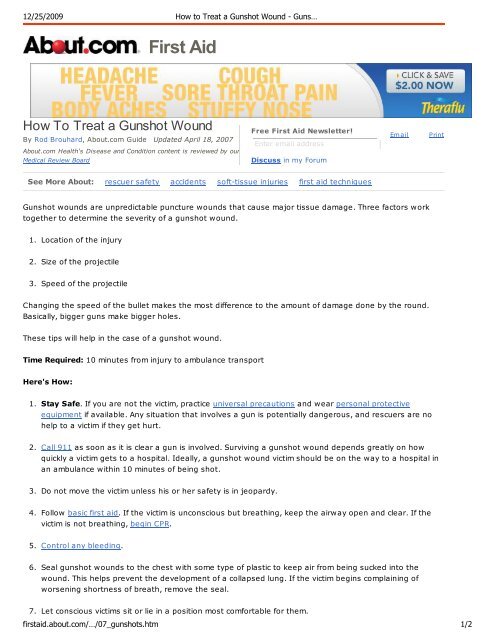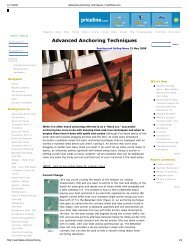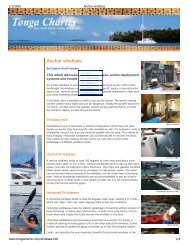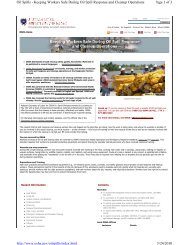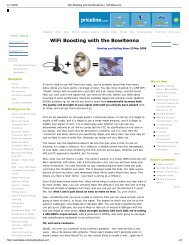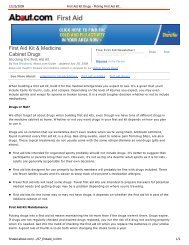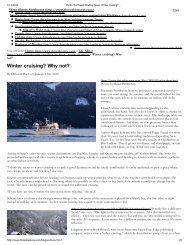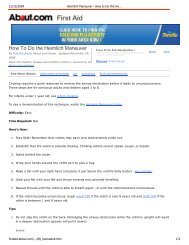Gunshot Wound First Aid.pdf - Grey Goose
Gunshot Wound First Aid.pdf - Grey Goose
Gunshot Wound First Aid.pdf - Grey Goose
Create successful ePaper yourself
Turn your PDF publications into a flip-book with our unique Google optimized e-Paper software.
12/25/2009 How to Treat a <strong>Gunshot</strong> <strong>Wound</strong> - Guns…<br />
<strong>First</strong> <strong>Aid</strong><br />
How To Treat a <strong>Gunshot</strong> <strong>Wound</strong><br />
By Rod Brouhard, About.com Guide Updated April 18, 2007<br />
About.com Health's Disease and Condition content is reviewed by our<br />
Medical Review Board<br />
Free <strong>First</strong> <strong>Aid</strong> Newsletter!<br />
Enter email address<br />
Discuss in my Forum<br />
Em ail<br />
Print<br />
See More About:<br />
rescuer safety accidents softtissue injuries first aid techniques<br />
<strong>Gunshot</strong> wounds are unpredictable puncture wounds that cause major tissue damage. Three factors work<br />
together to determine the severity of a gunshot wound.<br />
1. Location of the injury<br />
2. Size of the projectile<br />
3. Speed of the projectile<br />
Changing the speed of the bullet makes the most difference to the amount of damage done by the round.<br />
Basically, bigger guns make bigger holes.<br />
These tips will help in the case of a gunshot wound.<br />
Time Required: 10 minutes from injury to ambulance transport<br />
Here's How:<br />
1. Stay Safe. If you are not the victim, practice universal precautions and wear personal protective<br />
equipment if available. Any situation that involves a gun is potentially dangerous, and rescuers are no<br />
help to a victim if they get hurt.<br />
2. Call 911 as soon as it is clear a gun is involved. Surviving a gunshot wound depends greatly on how<br />
quickly a victim gets to a hospital. Ideally, a gunshot wound victim should be on the way to a hospital in<br />
an ambulance within 10 minutes of being shot.<br />
3. Do not move the victim unless his or her safety is in jeopardy.<br />
4. Follow basic first aid. If the victim is unconscious but breathing, keep the airway open and clear. If the<br />
victim is not breathing, begin CPR.<br />
5. Control any bleeding.<br />
6. Seal gunshot wounds to the chest with some type of plastic to keep air from being sucked into the<br />
wound. This helps prevent the development of a collapsed lung. If the victim begins complaining of<br />
worsening shortness of breath, remove the seal.<br />
7. Let conscious victims sit or lie in a position most comfortable for them.<br />
firstaid.about.com/…/07_gunshots.htm 1/2
12/25/2009 How to Treat a <strong>Gunshot</strong> <strong>Wound</strong> - Guns…<br />
8. Unconscious victims should be placed in the recovery position.<br />
9. Do not elevate legs to treat for shock if the gunshot wound is above the waist (unless the gunshot<br />
wound is in the arm). <strong>Gunshot</strong> wounds to the abdomen and chest will bleed more quickly once the legs<br />
are elevated, making it harder for the victim to breathe.<br />
10. Do not give the victim anything to eat or drink, including water.<br />
Tips:<br />
1. <strong>Gunshot</strong> wounds are puncture wounds and are typically treated the same. Don't expect to be able to tell<br />
the difference between entrance and exit gunshot wounds. There's no reliable way to tell and it doesn't<br />
matter.<br />
2. Bullets are unpredictable, and can bounce around the inside of a victim. A gunshot wound on one side of<br />
the body that lines up with a gunshot wound on the other side of the body may or may not be<br />
connected by a straight line. Various dynamics affect the path a round may follow.<br />
3. The tissue damage (overall injury) caused by a projectile is determined by multiplying the mass (weight)<br />
of the round by the velocity of the round squared. Since the speed of the round is squared in this<br />
equation, doubling the speed quadruples the energy and the damage.<br />
4. Handguns produce significantly slower velocity projectiles than rifles, and therefore typically cause less<br />
severe injuries. That's not to say that handguns are not dangerous, just that rifles cause bigger holes.<br />
5.<br />
Sources:<br />
Henry, Mark C., and Edward R. Stapleton. EMT Prehospital Care. 3rd Ed. 2004. Mosby/Jems.<br />
Explore <strong>First</strong> <strong>Aid</strong><br />
See More About:<br />
rescuer safety<br />
accidents<br />
By Category<br />
Calling for Help<br />
<strong>First</strong> <strong>Aid</strong> Kits<br />
Basic <strong>First</strong> <strong>Aid</strong><br />
<strong>First</strong> <strong>Aid</strong> Videos<br />
Travel Safety<br />
Emergency<br />
Preparedness<br />
Allergy &<br />
Anaphylaxis<br />
Burns and Fire<br />
Safety<br />
softtissue injuries<br />
first aid<br />
techniques<br />
Shortness of<br />
Breath<br />
Vomiting &<br />
Diarrhea<br />
Heart Attacks<br />
Strokes &<br />
Seizures<br />
Children<br />
Pregnancy &<br />
Childbirth<br />
Food Safety<br />
Must Reads<br />
AZ <strong>First</strong> <strong>Aid</strong><br />
<strong>First</strong> <strong>Aid</strong> Tools:<br />
Training and Kits<br />
When to C all 911<br />
Top <strong>First</strong> <strong>Aid</strong> Myths<br />
<strong>First</strong> <strong>Aid</strong> Kits<br />
Most Popular<br />
Burn Treatment<br />
Spider Bites<br />
Short of Breath<br />
Nausea C auses<br />
Diarrhea Treatment<br />
firstaid.about.com/…/07_gunshots.htm 2/2
12/25/2009 How to Treat a <strong>Gunshot</strong> <strong>Wound</strong> - Guns…<br />
firstaid.about.com/…/07_gunshots.htm 3/2


